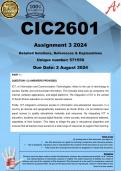Samenvatting
Samenvatting Pre-master Psychology - Conflict, Risk & Safety Theory 2
- Instelling
- Universiteit Twente (UT)
Summary of the module Conflict, Risk and Safety, theory 2. This summary includes all the required readings (papers) of part 2 of the module, and the information from the lectures.
[Meer zien]













